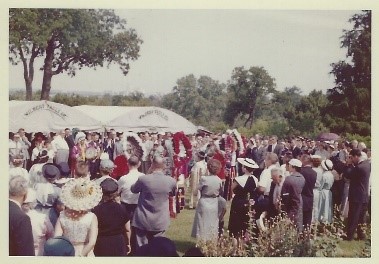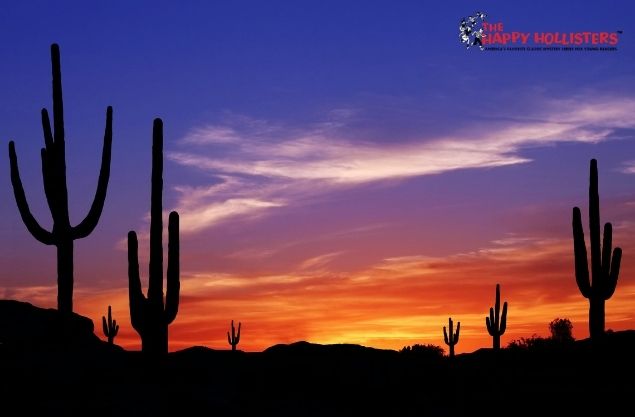 In The Happy Hollisters and the Indian Treasure, the Hollister family travels to Agua Verde, New Mexico, and solves a fun mystery with the help of some new friends from the Yumatan tribe. While Agua Verde and the Yumatans are fictional, author Andrew Svenson (writing under the pseudonym Jerry West) did some very real research in the American Southwest while writing the Happy Hollisters series.
In The Happy Hollisters and the Indian Treasure, the Hollister family travels to Agua Verde, New Mexico, and solves a fun mystery with the help of some new friends from the Yumatan tribe. While Agua Verde and the Yumatans are fictional, author Andrew Svenson (writing under the pseudonym Jerry West) did some very real research in the American Southwest while writing the Happy Hollisters series.
When the Happy Hollisters books were first published in the 1950s and 1960s, westerns were all the rage. Audiences loved exciting tales of life on the western frontier in movies like The Gunfighter and The Naked Spur, and in the popular television series The Lone Ranger. They also enjoyed stories by popular western authors such as A. B. Guthrie, Will Henry, and Louis L’Amour. The Stratemeyer Syndicate, the book packaging company that produced the Happy Hollisters along with The Hardy Boys and Nancy Drew, even jumped on the “chuckwagon” with the Bret King mystery series, which was published in the early 1960s and followed the adventures of a young “cowboy detective”1 in New Mexico. Many people loved westerns for the same reason that many readers love the Happy Hollisters today: they harkened back to an earlier time, with characters relying on their own wits, common sense, and upstanding morals rather than modern technology.
 As a fan of the western genre, Svenson took his research much farther than just reading novels or watching movies. Along with Squire Omar Barker, who wrote the Bret King novels under the pseudonym Dan Scott, Svenson was an early member of the Western Writers of America2, which was founded in 1953.
As a fan of the western genre, Svenson took his research much farther than just reading novels or watching movies. Along with Squire Omar Barker, who wrote the Bret King novels under the pseudonym Dan Scott, Svenson was an early member of the Western Writers of America2, which was founded in 1953.
He also travelled through the American Southwest to gather background material for The Happy Hollisters and the Indian Treasure, as well as The Hardy Boys Yellow Feather Mystery, which he outlined. He loved the area so much that he even considered moving his family from New Jersey to New Mexico!
In particular, Svenson spent time in the San Ildefonso Pueblo near Santa Fe. San Ildefonso Pueblo is a member of the Eight Northern Pueblos, and the people there speak a dialect of Tewa, an endangered language with fewer than 1,500 remaining speakers. In The Happy Hollisters and the Indian Treasure, the Hollister children learn Tewa phrases like “on-segee-an,” which means “how do you do,” and they learn how to say the Tewa names of their new friends, Red Feather and Blue Feather.
During his time in in the Southwest, Svenson toured several pueblos with Indian Detours, popular guided car tours which gave visitors the opportunity to explore the vibrant Native American cultures of the area. He also spent time with Popovi-Da, the former Governor of the San Ildefonso Pueblo who provided some of the background information for the Happy Hollisters and the Indian Treasure and made a cameo appearance in the book. Svenson was warmly welcomed and developed lifelong friendships with several of the Native Americans and other Southwesterners that he met during his travels. He was an invited guest at the 1959 funeral of Acee Blue Eagle, an artist from the Muscogee (Creek) Nation.


Funeral of Acee Blue Eagle; Photos by Andrew Svenson 1959
In his books, Svenson’s research and admiration for the American Southwest and its people shows through in his writing. In The Happy Hollisters and the Indian Treasure, the Hollisters solve the mystery of a lost turquoise mine while also learning about the Yumatan myths, culture, and traditions. Svenson peppers in actual Native American and western terminology as the Hollister children learn about pueblo homes, sample traditional Southwestern dishes like chili con carne and posole, and learn about the native plants and animals of the area—Ricky even has an unfortunate encounter with a “biting cactus.”

Many things have changed since Svenson researched and wrote his books in the 1950s and 1960s, and his depictions of Native Americans and the American Southwest in books like The Happy Hollisters and the Indian Treasure are a great opportunity for modern readers to reflect on how our cultural understanding has shifted throughout the years.
By Libby Svenson Kennedy
Sources:
- http://series-books.com/bretking/bretking.html
- https://westernwriters.org/
- https://santafeselection.com/blog/2014/06/21/indian-detours-now/
- Research Notes, Andrew Svenson Archives of The Hollister Family Properties Trust

